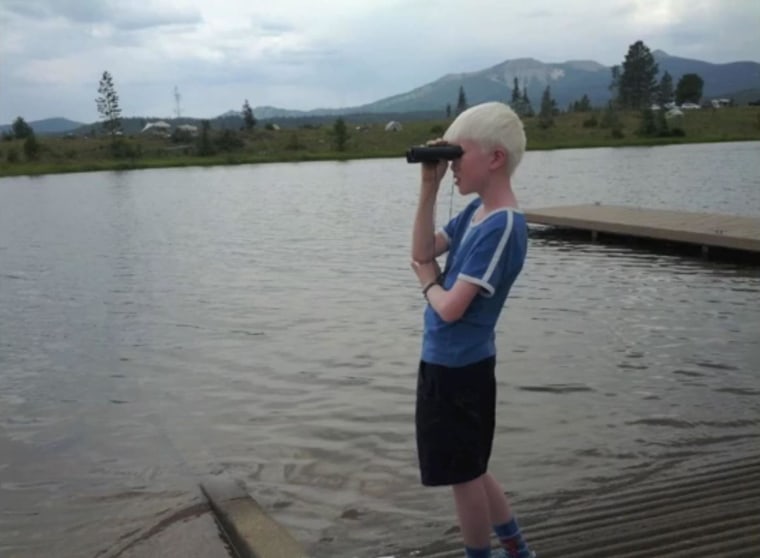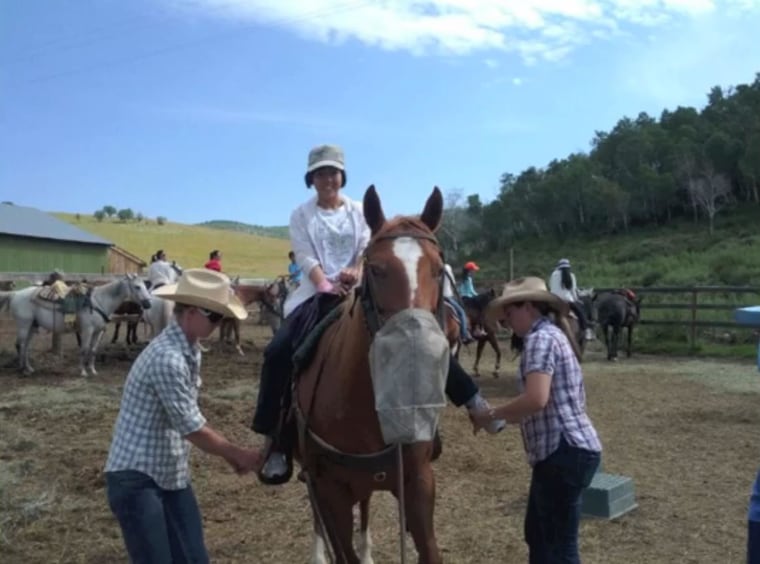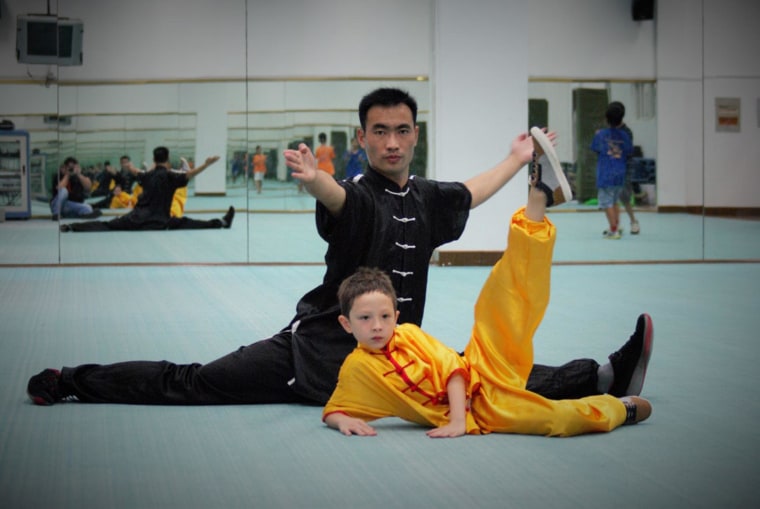The rowdy boys feasting on shredded pork tacos in Jen Holdeman’s Colorado backyard last summer weren’t her usual dinner guests. And tacos weren't the usual fare for the boys, a group of Chinese campers visiting the United States.
The Longfeifei Youth Summer Camp is an annual program operated in both Steamboat Springs, Colorado and Shanghai, China. At staggered times, two separate three-week camps integrate students between fifth and ninth grade from America, Asia and Europe for a cultural exchange that forges international ties and enriches understanding of culture and language.
This year’s Colorado camp — now called the Steamboat Mountain School — runs from July 21 to Aug. 8 after the Shanghai camp concluded on July 18.
Holdeman’s son Theo participated in his first session last year and will be returning again this year. One night last summer, all of the boys came to the Holdemans’ home for an evening of Nerf gun battles in the grassy backyard. They barreled across the lawn, shooting darts and laughing.
“For us, it was boys will be boys no matter where they’re from,” Jen said.
The Nerf gun battle was one of twelve-year-old Yinan “Sam” Wang’s favorite memories of that summer.
“It releases the kid from the textbook study and lets them be who they are”
He spent three weeks in Colorado drifting down rivers and swatting his new friends during pillow fights. The out-of-textbook learning was most rewarding for Wang, who attends school regularly in China where field activities aren’t as frequent.
The stories Sam brought home were informative for his mother, Haoping Xu, who found U.S. education emphasized sports and nature exploration.
“It releases the kid from the textbook study and lets them be who they are,” Xu said.

The camp’s roots are in Shanghai where director Fanghua Jiang started an after-school program to help her son adjust to their family’s return to China in 2009 after she had been working in New York City. Her project evolved into a three-week summer camp six years ago, and Jiang began looking for a partner in America.
That’s where she found a willing camp director in Michelle Raz, the director of the Chinese Academy as well as Learning Center at the Lowell Whiteman School in Steamboat Springs. It’s now been three years since the inception of the U.S. version, which hosts 24 students annually from the United States and China. In Shanghai, between 70 and 120 children convene from countries including Japan, Thailand, the United States, Germany and Sweden.
American student Bella O’Reilly spent three weeks at the Colorado camp last summer to experience the beauty of her own home while learning about how other people live. By the program’s end, her mother Stephanie O’Reilly found her nine-year-old daughter was more confident. O'Reilly says she was surprised by how open-minded the kids were. Conversations came down to the simple things: daily routines or how they spend their weekends.
Language isn't even necessary. Kids just purely play.
“As we grow older and grow up, we sort of get set in our ways, and we don’t really take that time to be as receptive to other cultures and learn more about them,” O’Reilly said.
Plotted within miles of green foliage atop a Rocky Mountain Peak, you’ll find the Steamboat Mountain School in Colorado. For some Chinese students with urban backgrounds, clean rivers and mountain animals are just as foreign as the English language.
“It’s a neat way for our kids locally who are kind of somewhat isolated to get a feel for what it’s like to be an international student, and for Chinese students to get a real eye-opening for how American kids live day-to-day in the Rocky Mountains in Colorado,” Raz said, adding that the firsthand account for Chinese students might “light up what they see in sitcoms.”
You push kids into comfort zones outside of their own places. They pushed through and developed some character they didn't even think they had.
While the inaugural camp in 2012 had no American students, each year comes with its revisions. This year’s run will be the first time American students can sleepaway. Like a traditional camp, an instructor leads all group activities with a maximum of 16 children, but there’s also a bilingual counselor. The camp counselors also post reports online to keep Chinese parents connected. The youngest kids are ten and the oldest 16.
“It’s a great way for the older kids to pair up with the younger and let their guard down, and the younger kids to role model the older,” Raz said.
The students chow down on meals — BBQ a staple — whipped up by a chef with local ingredients. Deer or elk dwell nearby, and one day is set aside for horseback riding on a ranch. A canopy of leaves hangs over their heads as they roast s'mores and swap ghost stories over a campfire at night time.

They paddle through the river, hike to natural hot springs and kick around soccer balls. Capture the flag is also a favorite. Creativity is stressed as students craft repurposed materials into masterpieces or swing around in performance-based dance.
Many of them don’t speak the same language, but they learn to converse, often best through interaction rather than classroom instruction. Basic Mandarin Chinese and English classes are offered.
“You push kids into comfort zones outside of their own places. They pushed through and developed some character they didn't even think they had,” Raz said.
A rigorous liberal arts lineup keeps the students occupied during the day.
“We don’t try to preach ‘China is good at this or bad at this.’ We just say, ‘Here, this is the similar age in China. These are kids from overseas. You guys may have things in common’”
The first year’s literature curriculum include American short stories. The second year, the kids perused Fitzgerald's Great Gatsby and experimented with slam poetry. For one student, a reaction piece he composed last summer called “The Green Light” was an admissions ticket to further education at a U.S. boarding school.
Jiang has tweaked her camp’s agenda over the years, and as an annual co-director in Colorado, she’s learned a lot about the youthful cross-cultural immersion.
“Most of the foreign kids, before they come here, they probably think China is still this… kind of relatively closed place,” Jiang said.
Friendship is most important for students to connect with a foreign country, Jiang says, and it’s key in cultivating an interest in the language. The Shanghai camp, too, offers a broad range of activities: practicing martial arts, planting in mini-gardens called pansais and glassblowing.

This year, students visited a local restaurant to experiment in the kitchen — stir frying, steaming and boiling — to prepare traditional Chinese cuisine.
The Longfeifei Mini Olympics wrap up the Shanghai sequence with anything from ping pong to the American-bred watermelon seed spitting. After three weeks together, the campers fling water balloons and compete in track and field races.
“We design those games because kids from all over the world love them... Language is not even necessary. Kids just purely play,” Jiang said.
It all comes down to exposure for Jiang, and the kids’ perceptions of the foreign country once they leave depend highly on the social aspect.
“We don’t try to preach ‘China is good at this or bad at this.’ We just say, ‘Here, this is the similar age in China. These are kids from overseas. You guys may have things in common,’” she said.